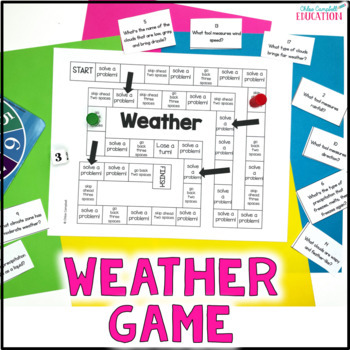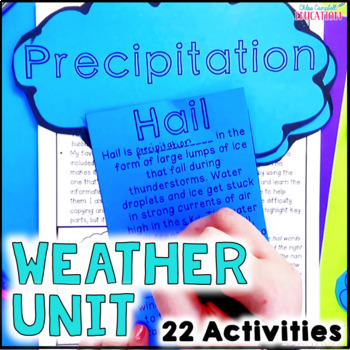Are you looking at your upper elementary weather lesson plans and feeling like they’re a little dreary? Keeping your students engaged and excited to learn about the weather can be a bit tricky. Weather is a science that your students experience every day. For this reason, your students may feel like they are already experts on the topic and want to check out before you even get started.

I’m sharing 6 ways to keep your weather lesson plans fun, hands-on, and engaging for your students. These strategies will help your students retain the material, relate it to their own lives, and have fun while learning all about weather and climates!
Why Teaching Weather and Climate in a Hands-On Way is Important
Weather is one scientific topic that your students will experience first-hand in their daily lives. It’s also a topic that easily lends itself to hands-on activities and interactive learning.
While students may feel they have a good understanding of weather simply by looking outside and reporting back what they see and feel, there are so many concepts they may not have experienced or been introduced to yet. Adding in additional engaging activities and hands-on lessons will help them to relate what they are learning in class to what they experience in real life, plus help them learn about weather events that may happen in different parts of the world.
6 Strategies to Make Engaging Weather Lesson Plans
Introduce Hand Motions
Using hand motions is a great way to make your lessons fun and make the material really stick. It also gets your students up and moving around, which can sometimes be a much-needed brain break.
One suggestion for using this strategy is to model the types of precipitation. I encourage my kids to come up with hand motions to demonstrate the four different types of precipitation. Every year they have been pretty creative and I’m usually pretty impressed by what they come up with on their own. This would be a great small group, team-building activity for your students too!
Also, remember to practice the hand motions at the beginning of each lesson to keep them fresh in their minds throughout the weather unit.
Use Interactive Notes
There are so many different types of interactive notes and they can be used for almost any subject or topic. I include lots of interactive note activities in my weather lesson plans. When students are writing the material in an interactive way, it helps them to retain and understand easier.
I use lots of foldable notes and even pop-up books during my weather unit. There are dozens of templates you can use or you can grab my weather unit bundle that includes ready-to-print resources.
You can even use foldable and interactive notes in an interactive science journal. Simply have your students complete the resource, then glue it to a page inside a notebook. This helps them keep all their notes in one place and makes it easy for them to review the information later.
Play Games
We all know that students love playing games in class. The best part of utilizing games during your lessons is that students end up enjoying the activity and having so much fun, they actually forget that they are learning in the process!
I use so many different types of games in my classroom – board games, matching games, and guessing games. They are just a great tool to have in your toolbox and can be used with any subject.
You can create dozens of weather-themed games using these formats. One of our favorites in class is playing matching games using our weather and climate vocabulary terms. This really helps the students remember the terms and their definitions, and creates some friendly competition.
I have also created a really fun and engaging weather board game for my students to play. You can download the weather board game for free from my Teachers Pay Teachers store!
Get creative and make games that will help your students have fun while learning the materials. Don’t have the extra time and need ready-made weather games? I’ve included quite a few in my Weather Unit Bundle that you can simply download and print!
Make Your Own Instruments
One of my student’s favorite parts of our weather unit is learning about weather instruments. If you have access to actual weather instruments, it’s great to allow the students to see and use those, but making their own is a great alternative.
Some instruments that you can make in class are barometers, rain gauges, and wind vanes. After creating the tools, allow your students time to use them and record the results. You can then compare their results against results from the real tools or from a local service.
Using their tools also allows the students to understand how the tool works, its purpose, and the data that it provides.
Create an Immersive Classroom
Fully immersing your students in weather and climate materials doesn’t have to be difficult or time-consuming. You can create an immersive, interactive setting for your weather unit by having your students create weather posters, building a weather vocabulary word wall, and displaying weather books, tools, and other materials.
I have my students create things like our types of precipitation mobile and hang them throughout the room. This activity is a great hands-on exercise to help them learn the types of precipitation and can double as a fun class decoration item.
Make It Relevant
Another great way to make weather lessons more exciting is to ensure they are relevant to your students. This means finding ways for students to apply what they are learning to their own lives or connect it to their own past experiences.
Creating daily weather briefs where students research and explain the current weather and conditions allows them to understand the concepts firsthand. You can choose to discuss the weather in your area and also choose a location that will have completely different weather patterns and phenomena.
Consider having a daily meteorologist who reports the current weather to the class and also shares an upcoming forecast. This allows the students to do some independent research (using a website like weather.com) and present information to the class.
This also makes it easier for students to recall later on in the future because they will be able to think about real-life examples that they have experienced or researched.
You can also use this type of activity to discuss climate zones and how the weather can differ greatly from one zone to another. Ask students if they have ever visited another climate zone and encourage them to describe the weather they experienced.
Print and Go Weather Unit Bundle
Do you need an easy way to implement all the strategies I shared above? Check out my Weather Unit Bundle with 22 hands-on and interactive weather activities, perfect for third, fourth, fifth, and sixth graders!
This weather unit bundle includes:
- Foldables, Crafts, Games, Assessments, and More
- DIY Build Your Own Weather Tools
- Discussion Cards
- Culminating project and assessment tools
This unit covers types of precipitation, how to track weather, weather tools, climate zone identification, and types of clouds. There are 75 pages of printable material included in this unit, making it so easy to simply print and go. Your students will have two weeks of exciting lessons and engaging activities with minimal prep on your part!
Do you have fun and engaging ways for teaching weather to your students? I’d love to hear some of the activities and games that you do in your classroom! Share them in the comments below!












Leave a Reply